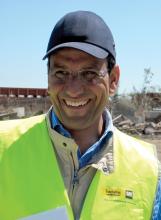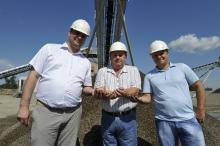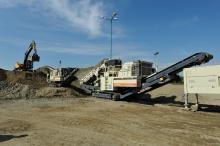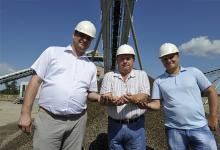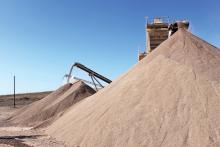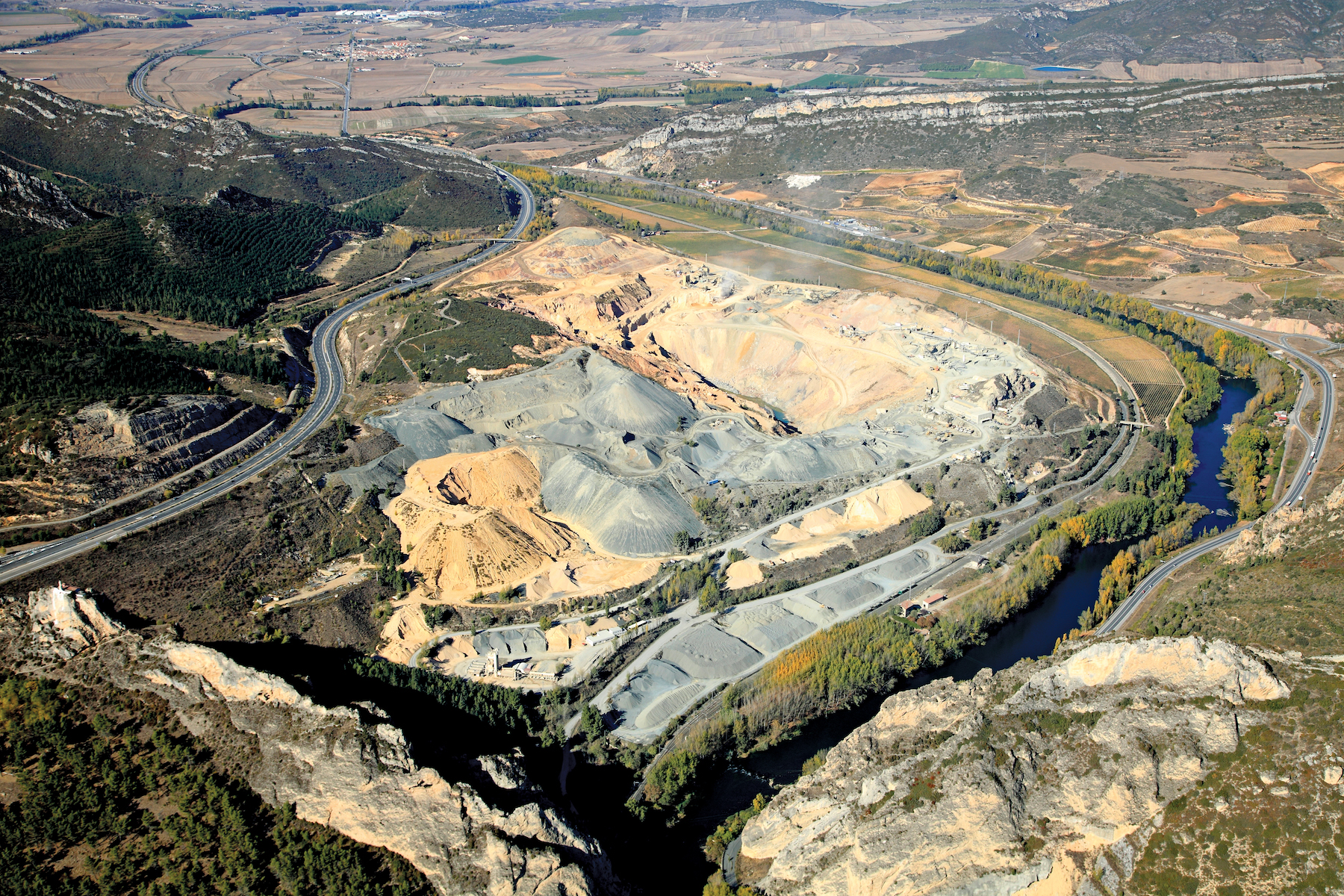
In a major Spanish wine region, one of the country’s biggest quarries has undergone a complete upgrade to produce high quality stone. Patrick Smith reports
The spectacular Las Conchas de Haro in Spain rises majestically above the road near Haro, which runs alongside the seemingly tranquil River Ebro.
At 910km long, the Ebro is one of the most important rivers in the Iberian Peninsula, and is the biggest river by discharge volume in Spain.
La Conchas de Haro and de Ebro is a natural channel between limestone rocks produced by the Ebro at its entry into the world-famous La Rioja region at an altitude of 445m. It marks the separation between the Montes Obarenes mountain by the Bilibio cliffs and the Sierra de Cantabria by the Buradón cliffs.
Here fine red wine is produced and at its heart is the city of Haro, capital of Rioja wine and host to the annual Haro Wine Festival where locals hold a wine battle.
Nearby, Iñigo Ajuria has a 34 hectare vineyard where he has grown Tempranillo grapes for about ten years, the bulk of which he sells to a winery in Haro. This is a hobby.
More importantly, Ajuria also runs the huge Ofitas de San Felices quarry which sits side-by-side with his vineyard.
As the Ebro running immediately alongside the quarry and the vineyard cannot be bridged for environmental reasons, a circular route leads over a bridge in Haro and then doubles back along a road to the quarry entrance through a tunnel, which has been hewn out of the rock.
The single-lane tunnel road opens out into a well-concealed 100hectare complex which is said to be among the oldest and possibly the largest of its type in Spain, and which produces a wide variety of aggregates including some of the highest quality ballast in the country. Its “star product” is taken out by train.
As the company name suggests, the rock quarried is ophite, greenish mottled rocks with ophitic texture such as diabase.
It is a material that is not very common in Spain and is rated 9-10 on the Los Angeles scale, a common test method used to indicate aggregate toughness and abrasion characteristics.
This provides ballast for the railway, including the high-speed lines, and infrastructure while limestone, also prepared in a separate operation at Ofitas de San Felices, is used as a building material.
The Ofitas de San Felices quarry has been completely upgraded over the last two years, and following completion last year a special event was held when visitors included the president of Metso Minerals, whose company supplied most of the new crushing and screening equipment, and whose Spanish distribution business manager is Ángel Luis García Del Val.
It has 10 million tonnes of reserves while a similar amount is available at a satellite quarry at Santutis, 25km away.
Quarrying started at Ofitas de San Felices in 1919 and a display book in the quarry offices details the first transactions. However, in 1973 Andoni Ajuria bought the site and his son Iñigo, who is director general, now runs the operation.
While today the quarry, which is some 60m deep (100m from the nearest hilltop), relies on the use of Metso equipment this is nothing new.
“The old plant was made up of many manufacturers but the crusher was a Nordberg [Metso] from the beginning,” says Iñigo, who is also involved with the new quarry plant at Santutis and the Ofitas de Cerro Sillado quarry at Guadix, Granada, southern Spain where Metso also supplied most of the equipment.
“The Ofitas de San felices quarry is very flexible. We can make whatever customers want.
“When it came to replacing the existing plant and moving it from its old site to the new site the design was done between Ofitas de San Felices and Metso and it was based on maintenance, simplicity and versatility.
“We have a relationsip with the company that goes back over 30 years and we have been loyal to this brand. We feel that the company is the best for us and we look on them as a partner. The relationship with the people from Metso is not just business it is a friendship.
“Thanks to sharing a similar, zero accident strategy and target with Metso, we have not encountered a single accident concerning crushing and screening equipment in our quarry since the 1970s.”
Indeed, for the new plant installation Ofitas de San Felices has bought from Metso a VF 561-2V feeder; C 125 jaw crusher; Nordberg HP400 cone crusher; Nordberg HP4 cone crusher; a Barmac 6150 crusher; CVB2060 IIIP screen; CVB2060 III screen; two CVB2060 IV screens and two TS 3.2 screens.
It also bought a Lokolink mobile conveyor, and it has two Metso Lokotrack LT 125 track-mounted jaw plants, one at Ofitas de San Felices for limestone and the other in operation at Santutis, and it was the first company in Spain to own one of these machines. Similarly, it was also the first company in Spain to buy the new generation HP4 cone crushers.
At Santutis everything from 0-1,000mm is reduced by the LT125 up to a 0-222mm size and transported in trucks to the Ofitas de San Felices plant.
However, in the main quarry, while the Metso screens deal with most materials, fractions of 0-30mm are sent to a special sieve screen that is produced by German company
It was decided to move the old plant to access the ophite material underneath and it has taken two years to build up the new plant because it was progressive.
“The old installation did not stop working until the new one was ready. We started to work with one line of the new installation while the old installation was still there,” says Iñigo.
A sub-contractor is employed for the drill and blast operations, with drilling being carried out using an
“We do one blast a week although the workload is not what it was,” says Iñigo.
“The sub-contractor uses 2,000kg of explosives and this produces around 20,000tonnes of rock for processing. The total production is around 1.5 million tonnes a year although the capacity is much higher. It is more than double this figure.”
Currently the quarry, which employs 30 people (70 two years ago), produces some 4,000tonnes/day caused by the lower demand, although at full capacity the plant is able to reach 8,000tonnes/day production of ophite, of which 30% is railway ballast; 60% smaller chips and sand and 10% of fines, and 6,000tonnes/day of limestone. Some 10,000tonnes is classed as waste.
The entire plant is run from a central control centre, which is set like the rest of the equipment on a 1m thick concrete slab.
Thanks to the versatile, two-line concept, connected by transverse conveyors, up to 12 different end products can be produced, and according to the demands for end products the material can be guided to the HP4 cone crusher or HP400 cone crusher followed by a Barmac vertical shaft impactor.
The Spanish regulations concerning end product cubicity are becoming more demanding with the flakiness percentage of railway ballast having to remain below 10% while for asphalt and concrete aggregates it is less than 15%.
DUMP TRUCKS
5 x Komatsu HD465
3 x Terex TR60
2 x Terex 3340
2 x Volvo A40D articulated trucks
EXCALVATORS
8 x Doosan DX520
WHEELED LOADERS
1 x Volvo L220E
1 x Volvo L180E
1 x Doosan DL 500
1 x Daewoo Mega500
FEEDER
1 x Metso Nordberg VF 561-2V
primary feeder
CRUSHERS
1 x Metso C125 jaw crusher
1 x Metso Nordberg HP400 cone crusher
1 x Metso Nordberg HP4 cone crusher
1 x Barmac (Metso) 6150 vertical shaft
impact crusher
SCREENING
1 x Metso CVB2060 III screen
2 x Metso CVB2060 IV screens
2 x Metso TS 3.2 screens
1 x Hein Lehmann sieve screen “With Metso’s HP4 cone and Barmac vertical shaft impactor (VSI) we can meet even the strictest cubicity demands. We believe that our high quality is helping us to survive over the present recession,” says mine engineer Carlos Fernandez.
When blasting is completed a fleet of eight
Material is carried in a variety of dump trucks including five
With its two separate production lines (the conveyors that carry the material around the site are covered to reduce dust pollution) the new plant is able to produce all end products required, from railway ballast to finer grades needed for asphalt and concrete.
At Ofitas San de Felices the initial process is formed by two parallel hopper structures on a concrete base where material that is blasted, between 0-800mm, goes into one hopper and the 0-220mm from Santutis goes in another.
The Metso Nordberg VF 561-2V primary feeder is followed by the primary crusher, the Metso Nordberg C125 jaw crusher which can achieve an output of between 290tonnes/hour with sizes up to 100mm and 650tonnes/hour up to 250mm in size.
The primary screen is a Nordberg CVB 2060 vibrating screen from Metso where the feed size is 200-250mm to which is added the 80-250mm from the stockpile.
At this point the process splits, and on one conveyor 40-80mm goes to one line while 40-80mm and below goes to another screen that will recover some chips to put back.
The high quality ballast (25-60mm) remains in two hoppers below the CVB 2060 screen as does the 6-30mm. This is to be recrushed. The other main end products are 0-2mm, 2-4mm, 4-10mm, 10-16mm and 16-22mm.
Secondary crushing on one line is carried out by the HP400 cone crusher while on the other independent line tertiary crushing is carried out by the HP4 cone crusher. The Barmac makes the shape.
All the ballast is taken from the quarry on state-owned Renfe trains with Ofitas de San Felices using one line of the Bilbao-Zaragoza line which runs through the vineyards near the winery owned by Iñigo.
“Other Spanish quarry companies have been looking at the Ofitas quarry. Those involved in hard rock and ballast look to Ofitas de San Felices as a benchmark,” he says.
“We hope to increase the total extraction of the three quarries from the present 1.5 million tonnes per year because our plant capacity allows more than double.”
Crushing grapes, not rock
Iñigo Ajuria started his vineyard about ten years ago as a hobby.
He cultivates 34hectares of vineyards next to the San Felices quarry, belonging to the famous Rioja wine area, where he harvests over 200,000kg of Tempranillo grapes most of which are sold to a local red wine maker. Recently, the company built its own wine processing plant to process 10,000–15,000kg of grapes for its own use.
The first vintage wine of Ofitas, harvested in autumn 2010, is now maturing in oak barrels, and after maturing for 12-15 months the wine is called crianza, and after two years it will be granted the classification reserva.
“Wine making is not a business but a hobby for us. Our wine is given out as presents, and used when meeting our sub suppliers and friends,” says Iñigo.

